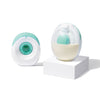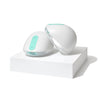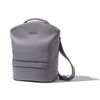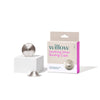We've learned a lot in the eight years since we launched the original wearable breast pump, but these eight lessons are some of the most important.
Eight years ago, efficient, comfortable, wearable breast pumps didn’t exist. As parents, innovators, and maternal health enthusiasts, we were frustrated. We believe that moms shouldn’t be tethered to a wall. That their schedules shouldn’t have to revolve solely around pumping. We knew that moms deserved a better breast pump. So we made one.
Willow launched in 2017, effectively creating the wearable breast pump category. Eight years later, we’re the #1 ranked, mom-approved wearable. Today our lineup goes far beyond breast pumps. Whether it’s the Find Your Flow Feeding Kit or our Portable Breast Milk Cooler, we support moms from the first drop to the last feed. And as you can imagine, we’ve learned a lot along the way.
Just like every new mom on her parenthood journey, there has been trial and error. We’ve listened. We’ve learned. We’ve taken big leaps. To celebrate how far we’ve come (and where we’re going!), here are eight things we’ve learned about breastfeeding and pumping from you, our amazing moms, and from our incredibly knowledgeable expert advisors and partners.
What we've learned
- Breastfeeding is not innate
- Any amount of breastmilk is good for you and baby
- Breastfeeding is not all or nothing
- Pump fit matters
- Pumping should never hurt
- You have the right to pump
- You are probably making enough milk
- You aren’t defined by how much milk you make
#1. Breastfeeding isn't an Innate Skill
It’s a skill you (and your baby) need to learn
The idea that breastfeeding is natural, and therefore should come easily is a myth. The fact: moms and babies may, by nature, have the ability to breastfeed, but they both lack the skillset––and any new skill takes time, practice, and patience. What’s been made crystal clear to us these past eight years is that breastfeeding is a work in progress, something you and your baby will learn together. Even if it feels instinctive, getting support can give you the confidence and information you need to reach your feeding goals. It can also make your experience a bit easier, less stressful, and more enjoyable.
Lactation consultants, also called IBCLCs or CLCs, specialize in all things related to baby feeding (including formula!). They’re an excellent resource when you encounter challenges, or even if you just have a long list of questions. Remember: Lots of questions are normal!
Breastfeeding is an ever-evolving journey, especially in the first six weeks. Pay attention to how you’re feeling, and connect with a lactation consultant (LC) as soon as something doesn’t feel right. Soreness? Pain? Discomfort? Don’t wait to get assistance. Whether or not you’re dealing with a pressing issue, an LC can give you the peace of mind you need to feed with confidence.
Book an appointment with an IBCLC with our partner, Simplifed
#2. Every Ounce Counts
Any amount of breastmilk has benefits for both baby and you
Feeding your baby can be one of the more stressful elements of the postpartum period. We all want what’s best for our new additions. But remember: Any amount of breast milk your baby receives is beneficial. The longer that you’re able to provide any amount, the longer the benefits last! In other words, feeding an infant is a marathon, not a sprint. It doesn’t matter if you breastfeed once a day or eight times a day. Every ounce matters. In fact, some studies show that just 50 ml (or 1.7 oz.) of breastmilk per day can provide babies with important nutritional and immune-boosting benefits.
Here are some tips on how to increase your supply
#3. Breastfeeding Isn't All or Nothing
There’s no one way to breastfeed
Ever heard (or believed) this sentiment: “If I pump or give my baby formula, I can’t say that I breastfed.”? It’s another myth! Breastfeeding moms often rely on supplementing and combo feeding. Think of formula and pumped milk in a bottle as a success tool, not a failure! Moms are more likely to breastfeed for longer if they can maintain this perspective. Ultimately, the goal is to ensure your baby receives the nutrition they need to thrive while you feel supported in your decisions and goals.
There are many reasons you may want––or need––to pump and bottle feed. Whatever they are, they’re all valid. Pumps can help establish breastfeeding in the early days, offer added flexibility and support (friends and family can feed the baby!), and help you maintain your supply when you’re away from your baby.
Here are some LC-approved tips for introducing a bottle to your baby
#4. Pump Fit Matters!
Like, really, really matters
Pumps may be one-size-fits-all, but flanges, which are the cone-shaped funnels that seal over your nipples to transmit milk, come in a few different sizes. When it comes to wearables, fit really matters––and it starts with your flange. Perfecting your flange fit will have a direct impact on your comfort and output while pumping.
The reason that flanges exist in different sizes is because nipple size varies from person to person, and even from breast to breast. We always like to say that they’re sisters, not twins! When your flange fits your nipple properly, it has a huge impact on your ability to efficiently, effectively, and comfortably express milk. We even make flange inserts to ensure you’ve got the absolute perfect fit for feeding.
Read more about the importance of the perfect flange fit
#5. Pumping Shouldn't Hurt
HELLO, oxytocin
While you may not feel it, all moms experience a “letdown” within a few minutes of starting to nurse or pump. This powerful reflex is what makes it possible for milk to travel through the breasts to the ducts and out of the nipple, and it’s all thanks to a special hormone called oxytocin.
Dubbed the “feel good” hormone, oxytocin plays an important role in output by sending a message to the brain that tells the breasts’ milk-producing cells to contract. Without these contractions, milk wouldn’t make its way to your baby––and you’d also likely feel less relaxed, since oxytocin is also known to reduce stress and induce feelings of calm.
The problem with a pump that pinches and pulls your nipple? Pain and discomfort can inhibit the release of oxytocin (not to mention leave you extra eager to end your pumping session), having an immediate impact on your body’s ability to produce milk. This is also true of stress, anxiety, and exhaustion, which is why breastfeeding mothers are encouraged to prioritize rest. In other words: more pumping comfort is directly connected to more milk output.
Here’s a deeper dive into why oxytocin is crucial to milk output
#6. Pumping In Public? Go Ahead!
You have the right to pump
Not everyone is especially eager to pump or nurse in public, but as maternal wellness advocates, we’re on a mission to help moms feel comfortable feeding their babies, wherever and however that may be. We spoke with Emily Varnam, a birth and postpartum doula, for some expert insights on pumping in public.
First and foremost, keep this in mind: “You have the right to pump and nurse in public spaces,” Varnam says. In fact, you have a right to pump breast milk for your baby anywhere within the United States, including at work and in airports, thanks to the Affordable Care Act’s Section 4207. You’re also protected at work through the Pump Act.
Prior to the passage of the Pump Act, only certain employees were guaranteed pumping rights (such as break time to pump and a private place to pump) under the Fair Labor Standards Act (FLSA).
In December 2022, the Consolidated Appropriations Act was signed into law. It includes the PUMP for Nursing Mothers Act (“PUMP Act”), which extends pumping rights to more than 9 million nursing employees. These employees include agriculture workers, nurses, teachers, truck and taxi drivers, home care workers, and managers working in hospitality––people who had previously been left out under FLSA.
Here an LC weighs in with tips on pumping in public
#7. You're Probably Making Enough Milk
Yes, really!
If you’re a mom obsessing over how to make more milk, even if your baby is healthy by weight standards, you’re not alone. Even with all the messaging that assures us that our bodies know how much milk to make for our babies, we can still get caught up in stocking the fridge and freezer with excess milk.
While temporary dips can happen, milk production stays about the same from months one to six, then actually slows slightly. That’s because older babies burn calories more efficiently, so their caloric needs actually go down. This can come as a shock to some. If you or your child care provider think your supply needs to increase, you’ll mistakenly think you aren’t making enough. If you’re worried about a dip in supply, it can help to know that two breasts combined make 1 to 1.25 ounces every hour. If you're pumping that volume, you know you’re fine.
Learn more about overproduction, underproduction, and your body’s (and baby’s) cues
#8. You Are Never––Ever–Defined By How Much Milk You Make
Motherhood cannot be quantified. You’re doing great. Seriously.
“Be careful about any instinct to quantify motherhood,” says Dr. Laurie Jones, a pediatrician and founder of Dr. MILK (Mothers Interested in Lactation Knowledge). “Since everyone expects you to breastfeed,” she says, you may be very focused on ensuring that your baby is getting enough milk. During early pediatrician visits, it may even be tempting to see your baby’s growth chart as a report card.
But Dr. Jones emphasizes: “You aren’t defined by the amount of breast milk you make, whether it’s directly feeding or pumping; you can’t quantify motherhood that way.” There are many “right” ways to be a parent, including how—and how much—you feed your baby. In consultation with your provider, you can define success for yourself and your baby, and feel good knowing that you’re doing the best you can.
Need a boost? Meet the Willow Mom Coaches who’ve been there
If you haven’t picked a pump yet, explore our Willow 360 and Willow Go pumps and join the hundreds of thousands of moms who trust their feeding journeys to Willow.
For more pumping tips, visit our blog and subscribe to our YouTube channel for expert-backed guidance.
Tags Used





